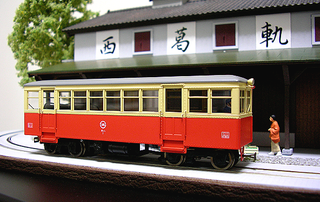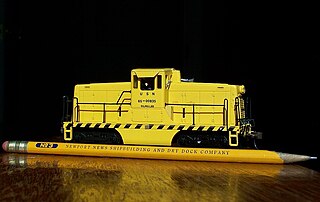Related Research Articles

Railway modelling or model railroading is a hobby in which rail transport systems are modelled at a reduced scale.

Lionel, LLC is an American designer and importer of toy trains and model railroads that is headquartered in Concord, North Carolina. Its roots lie in the 1969 purchase of the Lionel product line from the Lionel Corporation by cereal conglomerate General Mills and subsequent purchase in 1986 by businessman Richard P. Kughn forming Lionel Trains, Inc. in 1986. The Martin Davis Investment Group (Wellspring) bought Lionel Trains, Inc. in 1995 and renamed it Lionel, LLC.

O scale is a scale commonly used for toy trains and rail transport modelling. Introduced by German toy manufacturer Märklin around 1900, by the 1930s three-rail alternating current O gauge was the most common model railroad scale in the United States and remained so until the early 1960s. In Europe, its popularity declined before World War II due to the introduction of smaller scales.

HO or H0 is a rail transport modelling scale using a 1:87 scale. It is the most popular scale of model railway in the world. The rails are spaced 16.5 millimetres (0.650 in) apart for modelling 1,435 mm standard gauge tracks and trains in HO.

American Flyer is a brand of toy train and model railroad manufactured in the United States.
The Ives Manufacturing Company, an American toy manufacturer from 1868 to 1932, was the largest manufacturer of toy trains in the United States from 1910 until 1924, when Lionel Corporation overtook it in sales.

Gebr. Märklin & Cie. GmbH or Märklin is a German toy company. The company was founded in 1859 and is based at Göppingen in Baden-Württemberg. Although it originally specialised in doll house accessories, today it is best known for model railways and technical toys. In some parts of Germany and in Sweden, the company's name is almost synonymous with model railways.

A toy train is a toy that represents a train. It is distinguished from a model train by an emphasis on low cost and durability, rather than scale modeling. A toy train can be as simple as a toy that can run on a track, or it might be operated by electricity, clockwork or live steam. It is typically constructed from wood, plastic or metal. Many of today's steam trains might be considered as real ones as well, providing they are not strictly scale or not enough detailed ones in favor of a robustness appropriate for children or an inexpensive production.
K-Line Electric Trains is a brand name of O gauge and S gauge model railway locomotives, rolling stock, and buildings. Formerly the brand name under which Chapel Hill, North Carolina-based MDK Inc. sold its products, K-Line was then acquired by Sanda Kan, a Chinese toy manufacturer that formerly acted as K-Line's subcontractor. Sanda Kan had licensed the use of the K-Line brand and intellectual property to Lionel. More recently, the Lionel license expired, and Sanda Kan sold the dies to several other companies, with some going to each of Atlas, Bachmann, and RMT.
S scale is a model railroad scale modeled at 1:64 scale, S scale track gauge is 22.48 mm (0.885 in). S gauge trains are manufactured in both DC and AC powered varieties. S gauge is not to be confused with toy train standard gauge, a large-scale standard for toy trains in the early part of the 20th century.
Dorfan was an American toy company based in Newark, New Jersey from 1924 to 1934.
Z scale is one of the smallest commercially available model railway scales (1:220), with a track gauge of 6.5 mm / 0.256 in. Introduced by Märklin in 1972, Z scale trains operate on 0–10 volts DC and offer the same operating characteristics as all other two-rail, direct-current, analog model railways. Locomotives can be fitted with digital decoders for independent control. Model trains, track, structures, and human/animal figures are readily available in European, North American, and Japanese styles from a variety of manufacturers.

Bing or Gebrüder Bing was a German toy company founded in 1863 in Nuremberg, Germany by two brothers, Ignaz Bing and Adolf Bing, initially producing metal kitchen utensils, but best remembered for its extensive lines of model trains and live steam engines.
MTH Electric Trains is an American toy train and model railroad designer, importer, and manufacturer. A privately held company based in Columbia, Maryland, MTH is known as Mike's Train House.
Williams Electric Trains was an American toy train and model railroad manufacturer, based in Columbia, Maryland. Williams was sold to Kader via their subsidiary Bachmann Industries in October 2007, and is now identified as "Williams by Bachmann."

Lionel Corporation was an American toy manufacturer and holding company of retailers that was founded in 1900 and operated for more than 120 years. It started as an electrical novelties company. Lionel specialized in various products throughout its existence. Toy trains and model railroads were its main claim to fame. Lionel trains have been produced since 1900, and their trains were admired by model railroaders around the world for the solidity of their construction and the authenticity of their detail. During its peak years in the 1950s, the company sold $25 million worth of trains per year.

High rail is a phrase used in model railroading in North America, mostly in O scale and S scale, to describe a "compromise" form of modelling that strives for realism while accepting the compromises in scale associated with toy train equipment. The phrase exists due to the observation that traditional Lionel and American Flyer toy train track sits much higher than finescale track.

Rail transport modelling uses a variety of scales to ensure scale models look correct when placed next to each other. Model railway scales are standardized worldwide by many organizations and hobbyist groups. Some of the scales are recognized globally, while others are less widespread and, in many cases, virtually unknown outside their circle of origin. Scales may be expressed as a numeric ratio or as letters defined in rail transport modelling standards The majority of commercial model railway equipment manufacturers base their offerings on Normen Europäischer Modellbahnen (NEM) or National Model Railroad Association (NMRA) standards in most popular scales.
The Boucher Manufacturing Company was an American toy company that specialized in toy boats and toy trains. It is best remembered today as the last manufacturer of Standard Gauge/Wide gauge toy trains until the much smaller McCoy Manufacturing revived the old standard in the mid-1960s.

The Train Collectors Association (TCA) is an international non-profit organization of people who operate and collect toy trains, toy train accessories, toy train books, toy train paper, and anything else rail transport related. TCA was founded in October 1954 in Yardley, Pennsylvania and is currently headquartered in Strasburg, Pennsylvania. The National Toy Train Museum affiliated with TCA is included in the "List of museums in Pennsylvania".
References
- ↑ "Lionel Trains". www.tcawestern.org.
- ↑ "Classic Toy Trains Magazine - O Gauge Trains Operating, Collecting, Forums, Lionel Trains".
- ↑ "Ives Manufacturing Company" (PDF).
- ↑ "Tinplate FAQ Part 1". www.spikesys.com.
- ↑ "Dorfan Trains". www.tcawestern.org.
- 1 2 "American Flyer Trains". www.tcawestern.org.
- ↑ "Lionel 517 Caboose With Box Couplers Train99.com". www.train99.com.